Cyperaceae
Isolepis R.Br.
Family:
Common names: Sedges (Eng); madzhesi (Tshivenda)
Species
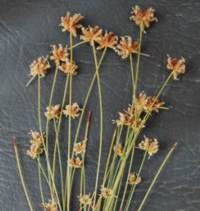
Isolepis antarctica (L.) Roem. & Schult.
Isolepis antarctica is an annual of about 80 to 200 mm tall, with numerous straw-coloured and dark red spikelets that consist of an indeterminate rachilla with many, spirally arranged glumes, with each glume subtending a bisexual flower. Its subtending glumes develop slowly and older glumes grow into a bonnet-like shape, protecting the fruit. It is widely distributed in damp flats and slopes up to 800 m altitude, from the Cape Peninsula to Langeberg Mountains in the Western Cape. It flowers between October to November.
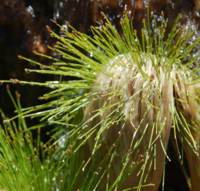
Isolepis digitata Schrad.
Isolepis digitata is a tufted perennial of about 150 to 200 mm tall, with green spikelets. It is commonly found attached to rocks in streams, below 1 000 m altitude, between Clanwilliam and Riversdale in the Western Cape. It flowers between September and January.
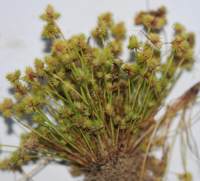
Isolepis hystrix (Thunb.) Nees
Isolepis hystrix is a small, densely tufted, annual species about 20 to 100 mm tall, with green spikelets. It is usually found in damp flats, and sometimes at altitudes of about 1 600 m. It is widely distributed from Namaqualand to the Cape Peninsula. This species flowers between August and November.
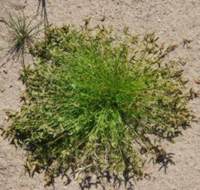
Isolepis levynsiana Muasya & D.A.Simpson
Isolepis levynsiana is a tufted annual up to 150 mm tall, with inflorescence and spikelets that are green or reddish, flattened with a distichous glume arrangement. It is widely distributed on lower mountain slopes, extending from Namaqualand in the Northern Cape to the Eastern Cape. Its flowers between September and January.
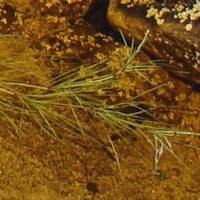
Isolepis striata (Nees) Kunth
Isolepis striata extends from Namaqualand to Riviersonderend to Uitenhage in the Eastern Cape, growing in pools at lower altitudes. It is a branched aquatic perennial with green or reddish terminal spikelets and glumes from 3.5 to 4.5 mm long. There are three involucral bracts that are shorter than the spikelets. The species flowers between August and December.
Plant Attributes:
Plant Type:
SA Distribution:
Soil type:
Flowering season:
PH:
Flower colour:
Aspect:
Gardening skill:
Special Features:
Horticultural zones
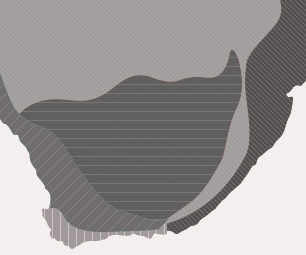
Trianoptiles Fenzl.
Family:
Common names: sedges (Eng.); biesies (Afr.)
Species
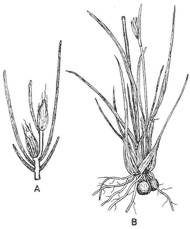
Trianoptiles capensis Harv.
This grass-like annual reaches 250 mm high and many of the aerial inflorescences project beyond the leaves. The greenish aerial spikelets form lax clusters on branches that arise in the axils of leaves. Most of the bisexual spikelets have five bracts and the perianth scale terminates in three bristles. The ovary is not stalked but terminates into a beak at the tip. The smoothly ribbed fruit is divided into three fused parts, the cell outlines clearly visible. The basal fruit is often found away from the central axis of the plant, as it tends to drift by intercalary growth.
T. capensis has a range extending from Ceres to the Cape Peninsula to Knysna.
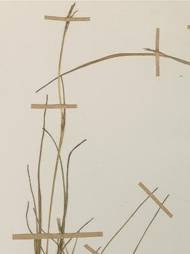
Trianoptiles solitaria (C.B. Clarke) Levyns ( Subterranean Cape sedge)
A tufted annual herbaceous plant growing to 30 cm in height. The leaves arise in dense bunches and are hairless. The ligule (or membranous outgrowth at the junction of the leaf sheath and blade) is absent. The aerial flowering stems are angular to flattened and usually do not project beyond the leaves, often being found to be hidden among the leaves. They arise either singly or in pairs. The greenish spikelet is long and narrow with three bracts. The axis above the first flower is united to the second bract along the majority of its length and the second flower appears superimposed on the first. The perianth scales are linear, hairy and barely longer than the ovary. The two lateral bristles are either absent or reduced.
See more below.

Trianoptiles solitaria (C.B. Clarke) Levyns ( Subterranean Cape sedge)
The ovary is 3-angular with an almost hairless beak-like tip. The fruit is about 2 mm long with a densely pitted surface.
The basal spikelet has an extensive sheathing bract around the style. The fruits ripen in the axils of the leaves close to the stems, unlike T. capensis where some intercalary growth occurs and the fruits ripen away from the main axis of the plant. This gives a superficial resemblance to the genus of fern Isoetes.
See more below.
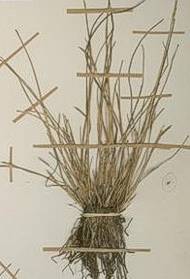
Trianoptiles solitaria (C.B. Clarke) Levyns ( Subterranean Cape sedge)
Interestingly enough, Subterranean Cape sedge is red listed as Critically Endangered in its local habitat, of which only fragments of natural vegetation remain on the Cape Flats, yet it is a declared weed in Australia, where it is on the Federal Government's Alert List for Environmental Weeds that was established in 2001. This is a list of weeds that currently pose more of a threat than a real problem but should be eradicated as they have the potential to cause significant damage.
(http://www.weeds.crc.org.au/documents/wmg_subterranean_cape_sedge.pdf)
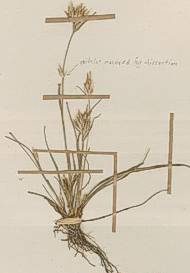
Trianoptiles stipitata Levyns
Reaching 20 cm in height, this species resembles T. capensis in its growth form, although the reproductive stuctures differ slightly. It also differs from T. capensis in that its perianth scales are larger, hairier on the outer surface, and also with a tuft of hairs on the inner surface below the bristles. It has a stalked ovary, and no cell outlines are visible at the intersections of the faces.
The species has scattered collections from the Calvinia District, Vanrhynsdorp, the Cape Peninsula and Bain's Kloof, although these seem to be localised population.
Plant Attributes:
Plant Type:
SA Distribution:
Soil type:
Flowering season:
PH:
Flower colour:
Aspect:
Gardening skill:
Special Features:
Horticultural zones

Ficinia Schrad.
Family:
Common names: sedges (Eng.); biesies (Afr.); Ficinia radiata : star grass (Eng.) stergras (Afr.)
Species

Ficinia gydomontana T.H.Arnold
F. gydomontana is endemic to the Gydoberg Mountains to the east of Ceres and the neighbouring Hottentotskloof. It occurs in mountain fynbos on summits and plateaus, sometimes in rocky areas and also in marshy patches. It is a tussocky perennial growing to 400 mm tall with brownish leaf sheaths; a terminal, dark brown inflorescence and whitish glume margins. Leaf blades and leafy bracts are absent.
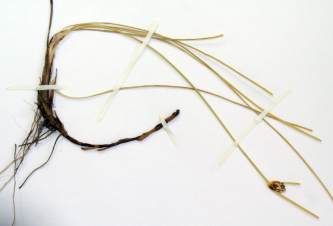
Ficinia pygmaea Boeck.
F. pygmaea is a low-growing, hairless, rhizomatous species. The rhizome is covered in pale brown scales. The stems stand solitary; each stem possessing tufted leaves that are chanelled near the base. The flower head has many pale brown spikelets. The species is known from lower mountain slopes in the Clanwilliam District.
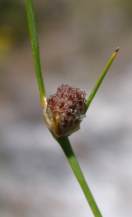
Ficinia dunensis Levyns
F. dunensis is endemic to the Western Cape where it is widely distributed, occuring in sand dunes or loose sand. Plants grow up to 200 mm high, possess horizontal stems and have leaves and aerial stems in small tufts. The horizontal stems are covered with dark brown scales when young and with age they become naked and wiry. The leaves are usually half as long as the flowering stems; the leaf sheaths are firm and deep red with the apex squared at the end. Leaf blades are thread-like. One to three spikelets occur in a compact terminal head that is enclosed by two sheathing bracts with wide, dark red-brown bases and leafy tips. The gynophore disc is well developed and lobed. Flowers are produced between August and October.
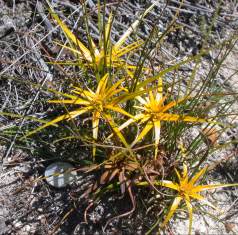
Ficinia radiata (L.f.) Kunth
Ficinia radiata is considered to be one of the most spectacular species of the Cyperaceae and is distinctly 'ficinioid' in appearance. Plants grow together to form a beautiful tufted display, each tuft comprising up to twenty individuals. The flower heads are located at the ends of culms (stems) and reach 150 mm in height. The bracts of the flower head are bright yellow and radiate spirally outwards, resembling a yellow star, hence the common name star grass.
The gynophore disc is large and well developed. The most significant difference between this species and other species of the genus Ficinia lies in the style branch that is markedly reduced so that the style is either unbranched or with three minute notches. The species grows in the southwestern region of the Cape Province where it is distributed from the Ceres Mountains southwards to Cape Town and the Western Cape. It grows on sandy lowlands and lower mountain slopes at altitudes between 200 and 2500 m. Flowering time is from September to December.
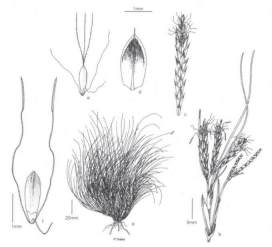
Ficinia esterhuyseniae Muasya
F. esterhuyseniae grows in moist rock crevices in sheltered overhanging rocks in the Western Cape from Swellendam to Clanwilliam at higher altitudes. It is a small, slender plant, growing in tufts with brownish leaf sheaths and leaves that are longer than the culms. The spikelets are cylindrical in shape.
The species is named after Miss Elsie Esterhuysen, a well-known plant collector who collected large amounts of material of Ficinia that is of much use to those attempting to understand the genus. Few other botanists have collected the species, perhaps because of its minute size and specialized habitat. The species is uncommon and if it were not for Elsie Esterhuysen's collections, it would have been poorly collected. Little is known about population size or distribution.

Ficinia micrantha C.B. Clarke
F. micrantha is a rare peninsula endemic, known only from damp peaty places on Table Mountain. Not many collections of this species have been made; the most recent collection is from a population that is now extinct because of a dam construction. The species grows up to about 120 mm high. Leaves are basally located and about half the length of the flowering stems. Leaf sheaths are firm and do not possess ligules. Leaf blades are flat just above the sheath and become cylindrical higher up. There is a single pale spikelet subtended by about six bracts, the lower of which is stiff and leaf-like and appears as a continuation of the stem.

Ficinia quinquangularis Boeck.
This species possesses densely tufted stems with a head of 1-4 chestnut-red spikelets. The upper sheaths are lance-shaped and leafless, whereas some of the lower sheaths bear leaves. It is known from rocky outcrops in mountain fynbos where it occurs from Swellendam east to the Outeniqua Mountains and also further east in the Tsitsikamma Mountains near Humansdorp.
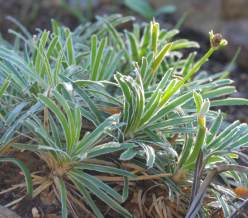
Ficinia truncata Schrad.
A hairless species with rigid horizontal stems covered in a dense array of hard brown scales. Over time the horizontal stems harden to form wiry rhizomes. The stems are 10-30 cm long and fairly rigid. Each stem holds a single rounded flower head. Leaves are flat, thick, parallel-sided and squared-off at the tip. The leaf margins are white and wear away, appearing tattered and membranous. The gynophore disc is rather long and narrow and its margin has three small teeth.
F. truncata occurs in the Riversdale, Mossel Bay and Uitenhage areas.
The species is popular in horticulture.
Plant Attributes:
Plant Type:
SA Distribution:
Soil type:
Flowering season:
PH:
Flower colour:
Aspect:
Gardening skill:
Special Features:
Horticultural zones

Cyperus textilis Thunb.
Family:
Common names: mat sedge, umbrella sedge, basket grass, rushes, emezi grass (Eng.); matjiesgoed, kooigoed, (Afr.); imisi (Xhosa)
Plant Attributes:
Plant Type:
SA Distribution:
Soil type:
Flowering season:
PH:
Flower colour:
Aspect:
Gardening skill:
Special Features:
Horticultural zones

Cyperus prolifer Lam.
Family:
Common names: miniature papyrus
Plant Attributes:
Plant Type:
SA Distribution:
Soil type:
Flowering season:
PH:
Flower colour:
Aspect:
Gardening skill:
Special Features:
Horticultural zones

Cyperus papyrus L.
Family:
Common names: papyrus (Eng.); papirus (Afr.); the bulrush of the Bible
Plant Attributes:
Plant Type:
SA Distribution:
Soil type:
Flowering season:
PH:
Flower colour:
Aspect:
Gardening skill:
Special Features:
Horticultural zones

Cyperaceae
Family:
Common names: sedges (Eng.); biesies (Afr.)
Plant Attributes:
Plant Type:
SA Distribution:
Soil type:
Flowering season:
PH:
Flower colour:
Aspect:
Gardening skill:
Special Features:
Horticultural zones

Bolboschoenus maritimus (L.) Palla (= Scirpus maritimus L.)
Family:
Common names: alkali bullrush (Eng.); snygras, snyruigte (Afr.)
Plant Attributes:
Plant Type:
SA Distribution:
Soil type:
Flowering season:
PH:
Flower colour:
Aspect:
Gardening skill:
Special Features:
Horticultural zones






Rate this article
Article well written and informative
Rate this plant
Is this an interesting plant?
Login to add your Comment
Back to topNot registered yet? Click here to register.